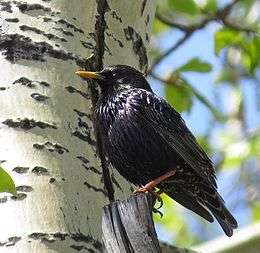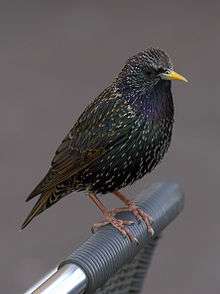Sturnus
| Sturnus | |
|---|---|
 | |
| European starling, Sturnus vulgaris vulgaris | |
| Scientific classification | |
| Kingdom: | Animalia |
| Phylum: | Chordata |
| Class: | Aves |
| Order: | Passeriformes |
| Family: | Sturnidae |
| Genus: | Sturnus |
| Species | |
|
see text | |
| Synonyms | |
|
Temenuchus (but see Systematics) | |
Sturnus is a genus of starlings. As discussed below, the taxonomy of this group is complex, and other authorities differ considerably in which species they place in this genus, and in the species boundaries within Sturnus. The genus name Sturnus is the Latin for "starling".[1]
This genus has representatives across most of Eurasia and one species, the European starling, has been introduced to South Africa, North America, Australia and New Zealand.
The Sturnus starlings are terrestrial species; they walk rather than hop, and have modifications to the skull and its muscles for open-bill probing. The latter adaptation has facilitated the spread of this genus from humid tropical southern Asia to cooler regions of Europe and Asia.
The more northerly breeding species are completely or partially migratory, wintering in warmer regions.
Sturnus starlings nest in holes in trees or buildings. They are omnivorous and mostly feed on the ground; they specialise in taking invertebrates from just below the surface. This is facilitated by the head adaptations mentioned above, which enable the birds to probe with the bill open, closing it to secure prey items.
The plumages within this group are variable, but all the species have the starling's familiar triangular wing shape.
Taxonomy and systematics

The European (the type species) and spotless starlings are particularly closely related, and interbreed to some extent where their ranges overlap in southwestern France and northeastern Spain. The non-migratory spotless starling may be descended from a population of ancestral S. vulgaris that survived in an Iberian refugium during an ice age retreat.[2]
Extant species
Two extant species are recognized:
| Image | Scientific name | Common Name | Distribution |
|---|---|---|---|
 | Sturnus vulgaris | Common starling | its native range in temperate Europe and western Asia |
.jpg) | Sturnus unicolor | Spotless starling | the Iberian Peninsula, northwest Africa, southernmost France, and the islands of Sicily, Sardinia and Corsica |
Mating system
A mating system is vastly different from reproduction. It includes all the benefits and costs that the female weighs when choosing a mate and the competition that males, and sometimes females, go through when trying to win over a mate. The genus Sturnus contains a variety of mechanisms that factor into their complex mating system. There are three major mechanisms that we see in Sturnus species. Sexy son's hypothesis, parental care, and differential allocation are the three mechanisms that factor into this mating system
Parental Care
Male Sturnus unicolor individuals face a choice when it comes to the mating season. They can either invest in parental care, through helping feed the young, provide shelter, etc. and be monogynous or they can control many nests at one time, increase the number of matings they engage in and be polygynous.[3] To add to this, much of the time their choice is biological. Sturnus unicolor males are more likely to be polygynous and be less involved in parental care if they have higher levels of testosterone. In addition, females of the Sturnus vulgaris species see a decrease in their fitness if the male is polygynous because there is no assistance in nestling feeding.[4] Offspring success per nest, however, is significantly higher if there is parental care from the male, but males see greater overall fitness when they are polygynous. This is the trade off and the cost/benefit balance that each individual must go through.
Differential Allocation
To try and make the males stay monogamous to them, females will act aggressively towards females that threaten this. If the male looks like he is going to leave, she will perform aggressive acts towards this female in an attempt to have the male stay.[5] Males actually respond to this and the aggressive acts towards prospecting females does play a role in whether the male stays monogamous or not.[6] The females then respond to whether or not the male sticks around to invest in parental care. She will allocate more maternal steroid hormones to the later laid eggs if the father stays monogamous.[7] She does this because it negates the effects of hatching asynchrony. When the female is alone she has a tough time coming up with enough resources to fully take care of all the offspring. Therefore, if the male is monogamous, she allows all the young to hatch at a similar time, and at a similar nutritional state. If the male is not around, she will allow the hatching asynchrony and even allow a brood reduction because she cannot take care of all the young. This allocation of resources to the more desirable situation is differential allocation.
Sexy Son's Hypothesis
This mechanism is to account for the reason why a female may in fact mate with a previously mated male (polygynous). The hypothesis explains that the female may also choose to mate with a previously mated male because he is already proven himself to be successful, and thus he will pass down these successful mating genes to his sons.[8] Although it may not be ideal for the female at the time, her genes likely get passed on for many generations due to the success of her son's because the sons gain many of the behavioral qualities that the father had, which would likely cause them to also be highly successful in their sexual maturity. This hypothesis obviously has its critics because why would a female risk her own health for a chance that her sons grow up to be successful and pass her genes on. This is a very valid proposition and has been shown to be flawed in some scenarios. Females that mate with previously mated males, because they also likely leave the nest, fledged far less young than those that mated with monogamous males.[9]
Former species
Formerly, some authorities also considered the following species (or subspecies) as species within the genus Sturnus:
- Straw-headed bulbul (as Sturnus zeylanicus)[10]
References
- ↑ Jobling, James A (2010). The Helm Dictionary of Scientific Bird Names. London: Christopher Helm. p. 367. ISBN 978-1-4081-2501-4.
- ↑ Zuccon, Dario; Pasquet, Eric; Ericson, Perg P. (September 2008). "Phylogenetic relationships among Palearctic–Oriental starlings and mynas (genera Sturnus and Acridotheres: Sturnidae)" (PDF). Zoologica Scripta. 37 (5): 469–481. doi:10.1111/j.1463-6409.2008.00339.x.
- ↑ Moreno, Juan; Veiga, Jose; Cordero, Pedro; Minguez, Eduardo (1999). "Effects of paternal care on reproductive success in the polygynous spotless starling Sturnus unicolor". Behavioral Ecology and Sociobiology. 47 (1–2): 47–53. doi:10.1007/s002650050648.
- ↑ Sandell, Maria; Smith, Henrik; Bruun, Mans (1996). "Paternal care in the European starling, Sturnus vulgaris: nestling provisioning". Behavioral Ecology and Sociobiology. 39 (5): 301–309.
- ↑ Smith, Henrik; Sandell, Maria (2005). "The starling mating system as an outcome of the sexual conflict". Evolutionary Biology. 19 (2): 151–165. doi:10.1007/s10682-004-7915-5.
- ↑ Sandell, Maria (1998). "Female aggression and the maintenance of monogamy: female behaviour predicts male mating status in European starlings". Proceedings of the Royal Society B: Biological Sciences. 265 (1403): 1307–1311. doi:10.1098/rspb.1998.0434. PMC 1689209.
- ↑ Gwinner, Helga; Schwabl, Hubert (2005). "Evidence for sexy sons in European starlings (Sturnus vulgaris)". Behavioral Ecology and Sociobiology. 58 (4): 375–382. doi:10.1007/s00265-005-0948-0.
- ↑ Gwinner, Helga; Schwabl, Hubert (2005). "Evidence for sexy sons in European starlings (Sturnus vulgaris)". Behavioral Ecology and Sociobiology. 58 (4): 375–382. doi:10.1007/s00265-005-0948-0.
- ↑ Pinxten, Rianne; Eens, Marcel (1990). "Polygyny in the European starling- effect on female reproductive success". Animal Behaviour. 40: 1035–1047. doi:10.1016/s0003-3472(05)80171-x.
- ↑ "Pycnonotus zeylanicus - Avibase". avibase.bsc-eoc.org. Retrieved 2017-03-08.